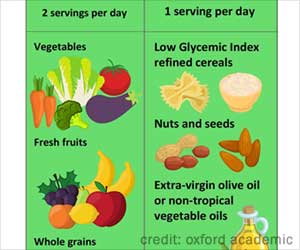Learn about the defining features and varying effects of popular diets. Discover the best approach to sustainable weight loss and overall health.
- Diets have different defining features, such as macronutrient ratios and food restrictions
- Different diets have varying effects on weight loss and health markers
- Sustainable weight loss is best achieved through a balanced, personalized approach
Cardiometabolic Health and American Heart Association's Dietary Guidance
Cardiometabolic health refers to factors that affect metabolism and the risk of heart and vascular disease, including blood glucose, cholesterol, blood pressure, and body weight. The AHA's dietary guidance includes ten key features of a dietary pattern that improve cardiometabolic health, emphasizing limiting unhealthy fats and reducing the consumption of excess carbohydrates.This balance optimizes both cardiovascular and general metabolic health and limits the risks of other health conditions, such as Type 2 diabetes and obesity, resulting from excess consumption of carbohydrates, particularly processed carbohydrates and sugar-sweetened beverages.
Dietary Patterns:
The statement reviewed defining features of several dietary patterns meant to be followed long-term and grouped them by similarity in key characteristics, resulting in 10 categories:DASH-Style
: This eating pattern is like the Dietary Approaches to Stop Hypertension (DASH) diet, emphasizing vegetables, fruits, whole grains, legumes, nuts, and seeds, low-fat dairy, and includes lean meats, poultry, fish, and non-tropical oils. The Nordic and Baltic diets are other types of this eating pattern (1✔ ✔Trusted SourceDietary supplements for erectile dysfunction: A natural treatment for ED?
Go to source).
World Health Organization on the DASH Diet:
"The DASH diet emphasizes vegetables, fruits and low-fat dairy products, and includes whole grains, poultry, fish and nuts. It is rich in potassium, calcium, and magnesium, as well as fiber and protein."Mediterranean-Style
: Also known as the Mediterranean diet, this pattern limits dairy, emphasizes vegetables, fruit, whole grains, legumes, nuts and seeds, fatty fish, and extra virgin olive oil, and includes moderate drinking of red wine."The Mediterranean diet emphasizes eating primarily plant-based foods, such as fruits and vegetables, whole grains, legumes and nuts. It replaces butter with healthy fats, such as olive oil and canola oil, and uses herbs and spices instead of salt to flavor foods."
Vegetarian-Style or Pescatarian Diet
: A plant-based eating pattern that includes fish.Vegetarian-Style or Ovo or Lacto Diet
: Plant-based eating patterns that include eggs (ovo-vegetarian), dairy products (lacto-vegetarian), or both (ovo-lacto vegetarian).Vegetarian-Style/Vegan Diet
: A plant-based eating pattern that includes no animal products.A vegetarian Diet
: It focuses on plants for food. These include fruits, vegetables, dried beans and peas, grains, seeds and nuts. There is no single type of vegetarian diet.Instead, vegetarian eating patterns usually fall into the following groups: the vegan diet, the lacto-vegetarian diet, the ovo-vegetarian diet and the lacto-ovo-vegetarian diets.
Low-Fat
: A diet that limits fat intake to less than 30% of total calories, including the Volumetrics eating plan and the Therapeutic Lifestyle Change (TLC) plan.Very Low-Fat
: A diet that limits fat intake to less than 10% of total calories, including Ornish, Esselstyn, Pritikin, McDougal, Physicians Committee for Responsible Medicine (PCRM) diets. Some may also be considered vegan.Low-Carbohydrate
: A diet that limits carbohydrates to 30-40% of total calorie intake, including South Beach, Zone diet, and low glycemic index diets.Paleolithic
: Also called the Paleo diet, it excludes whole and refined grains, legumes, oils, and dairy.Very Low-Carbohydrate/Ketogenic
: Limits carbohydrate intake to less than 10% of daily calories and includes Atkins, ketogenic, and the Well-Formulated Ketogenic diets.Evaluation of Dietary Patterns
Each diet was evaluated against nine of the ten features of the AHA's guidance for a heart-healthy eating pattern. The only element not used in scoring was "eating to achieve a proper energy balance to maintain a healthy weight," since this is influenced by factors other than dietary choices, such as physical.There are several defining features of popular diets that people often follow. One of the most common features is a focus on whole, unprocessed foods. Many diets promote eating a variety of fruits, vegetables, lean proteins, and healthy fats while avoiding processed and packaged foods high in sugar, salt, and unhealthy fats.
Another feature is the concept of calorie restriction. Many diets recommend reducing overall caloric intake to promote weight loss and improve health outcomes. This can be achieved through portion control, tracking food intake, or following specific meal plans that dictate how many calories to consume per day.
Some diets also restrict or eliminate certain food groups, such as carbohydrates or dairy, while emphasizing others, such as protein or plant-based foods. For example, the ketogenic diet is a high-fat, low-carbohydrate diet that encourages the body to enter a state of ketosis, where it burns fat for fuel instead of carbohydrates.
Similarly, the paleo diet focuses on foods that were available to humans during the Paleolithic era, such as meats, vegetables, and fruits, while avoiding processed and refined foods.
Intermittent fasting is another popular dieting approach. This involves alternating periods of eating with periods of fasting, ranging from a few hours to several days. Proponents of intermittent fasting suggest that it can improve metabolism, promote weight loss, and improve insulin sensitivity.
While there are many different diets to choose from, it's important to remember that what works for one person may not work for another. It's also essential to consider the potential risks and benefits of any diet before starting, as some may be more effective and sustainable than others.
In addition to considering the diet itself, it's important to look at the underlying motivations behind dieting. For some, a desire to lose weight may be the primary motivator, while others may be seeking improved health outcomes or managing specific medical conditions.
It's important to remember that diets are just one part of a healthy lifestyle. Other factors, such as regular exercise, adequate sleep, and stress management, also play important roles in overall health and well-being. By focusing on a holistic approach to health and wellness, individuals can create sustainable habits and achieve long-term success in reaching their goals, activity level, and applies equally to all the diet categories.
References:
- Dietary supplements for erectile dysfunction: A natural treatment for ED? - (https://www.mayoclinic.org/diseases-conditions/erectile-dysfunction/in-depth/erectile-dysfunction-herbs/art-20044394)
Source-Medindia












